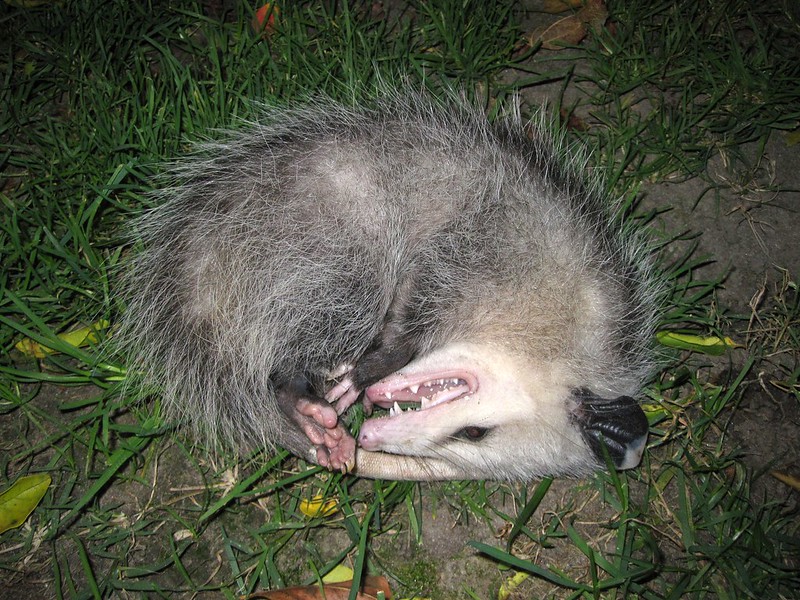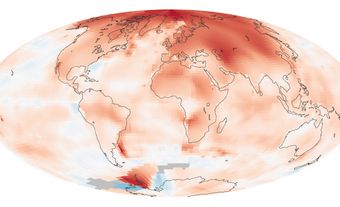The Virginia opossum (Didelphis virginiana) is Canada’s only marsupial. It belongs to one of three marsupial families native to the Americas. The Virginia opossum’s northernmost range reaches into Southern and Southeastern Ontario, Southern Quebec and the lower Fraser Valley in British Columbia. However, this range is slowly expanding north, likely due to climate change.

Description
Virginia opossums are about the size of a house cat. They have coarse, greyish fur, whitish faces with long, pointed snouts, naked, round ears, and beady eyes. Their tails are rat-like and prehensile, meaning they can grasp items and aid in climbing. Contrary to popular belief, only juvenile opossums are light enough to use their tails to hang upside down.

Aside from primates, koalas and giant pandas, opossums are the only mammals that have opposable “thumbs.” For opossums, it is their “big toe,” called a hallux, that is opposable. The hallux helps to make opossums excellent climbers. In contrast, on ground level, opossums have a slow, almost wobbly, gait.
Female opossums are called jills, males are jacks, and babies are joeys.
Did you know?
The name “opossum” is an anglicized version of the Algonquian word apasum or apousoum, which means “white animal.” The “o” was later dropped and “possum” became the slang name. However, using the term possum is misleading when referring to opossums. The possum is of the order Diprotodontia, native to Australasia, and the opossum is of the order Didelphimorphia. Since European colonists arrived in Australia years after arriving in the Americas, they thought possums were opossums due to their physical similarities, and gave them a similar name.
Reproduction and Development
Virginia opossums are seasonal breeders with multiple breeding periods per year. Depending on latitudes, they may begin breeding as early as January and birth litters as late as September. Usually, females have one or two litters per year, but can have a third litter if climatic conditions are favourable. Opossums are mainly solitary animals. They have been thought to display social behaviour only when mating, however recent studies suggest that their social behaviour is more complex.
All marsupial young are born in an underdeveloped state after a short gestation period. Virginia opossums have a gestation period of about 11 to 13 days. When the babies are born they are about the size of a dime, furless and blind. Their forelegs and sense of smell help them crawl their way to the mother’s nipples (called teats) to continue development inside the pouch. Females usually have 13 teats arranged in the shape of a horseshoe. If a mother gives birth to more than 13 babies only those that are able to latch onto a nipple will survive.
It takes about two months before the babies are able to exit the pouch for short periods. During this time, the young will grasp onto their mother’s back and be carried in a “piggyback” fashion. After the third month, the babies are fully weaned and independent.
Virginia opossums have very high mortality rates. They often don’t make it past 2 years of age, unless in captivity, in which case they may live up to 10 years. The most common causes of death are predation and car collisions.
Habitat
The Virginia opossum is not picky when it comes to habitat selection. As long as there is a water source and abundant food, they may be found foraging in deciduous forests, prairies, and marshes. They will build their dens in crevices, woodpiles, rock piles, abandoned animal burrows, under porches, and inside holes in buildings. The Virginia opossum’s range is expanding north, due in part to their ability to adapt to various urban and agricultural landscapes, as well as the rise in global temperatures ( see Climate Change).
Diet
Studies have shown that the opossum’s diet and habitat are very similar to raccoons. Both species are omnivorous and opportunistic feeders, eating a variety of plant and animal matter. In addition, both raccoons and opossums have successfully adapted to foraging through garbage for human food. Conflict between the species seems limited, apparently due to some differences in food preferences and foraging hours.
With a total of 50 teeth, Virginia opossums have the most teeth of any North American land mammal. Their teeth include sets of molars, premolars, canines, and incisors, all of which help them to eat virtually any type of food. Opossums will eat invertebrates such as insects and worms, small mammals, leafy matter from grasses and woody plants, and soft mast such as berries. The Virginia opossum is primarily a nocturnal species, foraging from dusk to dawn; however, in the winter, they sometimes switch to daytime foraging due to warmer daytime temperatures and scarcity of food.
Behaviour

Opossums are characterized by a famously unusual behaviour known as “playing possum” or “playing dead.” As a defense mechanism, opossums go into a curled up, catatonic state, appearing to be dead. They emit a foul-smelling substance from their anal glands, mimicking the smell of decaying flesh. While in this state, the opossum’s heart rate decreases, allowing them to “play dead” for up to six hours. They generally bare their teeth, foam at the mouth, and leave their tongues hanging out. When they no longer feel threatened, they’re able to recover and escape within minutes. This defense mechanism is effective since most predators will not eat prey that is already dead and decaying, unless they are scavengers.
Did you know?
Virginia opossums are resistant to the snake venom of some North American snake species. Studies show that opossums have a certain peptide in their blood that neutralizes the venoms. For this reason, opossums are studied in order to develop ways to treat human snakebite victims.
Relationship with Humans
Some people consider opossums a pest species. However, opossums are travellers and will not stay in the same area for a long time. Therefore, they will not deplete a crop as might other animals. Opossums will eat creatures commonly found in backyards, such as beetles, spiders, crickets, snails and slugs. If unwanted, opossums may be eliminated from backyards by leaving a light on, playing a radio, using garbage bins with tight lids and keeping pet food inside. While the Virginia opossum can be a carrier for a number of parasites, it is uncommon for this species to carry the rabies virus.

 Share on Facebook
Share on Facebook Share on X
Share on X Share by Email
Share by Email Share on Google Classroom
Share on Google Classroom



